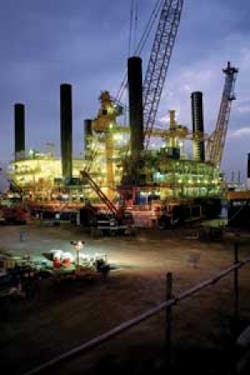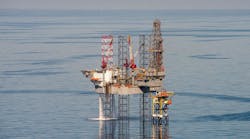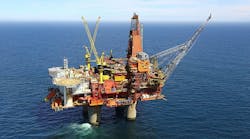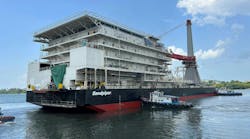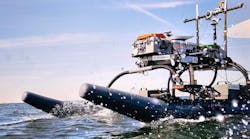Ray Boswell
Gas Hydrate R&D Programs
U.S. Department of Energy
National Energy Technology Laboratory
Research results over the past decade, including drilling and coring, experimental studies, and numerical simulations, are clarifying the resource potential of gas hydrates. Key to recent advances is the recognition that gas hydrate is not something exotic, requiring fundamentally new technologies. Instead, gas hydrate is best thought of as the shallow extension of existing deepwater petroleum systems, fully amenable to exploration and potential production using the same tools and concepts as traditional hydrocarbon resources. The conduct of the impending field sampling and production tests will be the next major step in the evaluation of this potential resource.
Methane hydrate, a solid compound formed from the inclusion of methane molecules within an open lattice of water molecules, is familiar to those who work in deepwater oil and gas exploration and production. The formation of solid gas hydrate plugs within drilling and production tubulars and equipment is a well-known hazard. However, this article is not about hydrate that forms as a consequence of offshore operations, but instead about issues related to naturally occurring hydrate that forms and evolves gradually over geologic time within the shallow sediments of deepwater continental slopes and shelves.
Gas hydrates require an unusual combination of relatively cold temperatures and relatively high pressures to become stable. In the early 1960s, scientists in Russia noted that methane and water co-exist widely in areas of the Siberian permafrost, and speculated that gas hydrate might be responsible for some unusual reservoir behavior observed in shallow western Siberian gas reservoirs.1 In the early 1970s, gas hydrates were inferred to occur in arctic Alaska and Canada as well, and speculation began that gas hydrate could exist in the marine environment in significant volumes.
The physical occurrence of gas hydrate was confirmed by scientific drilling expeditions in late 1970s and early 1980s that recovered natural gas hydrate samples from the continental shelves of North and Central America. By the mid 1990s, there was general consensus that gas hydrates in nature likely housed as much organic carbon as all known oil, gas, and coal deposits combined.2
The pressure temperature requirements for gas hydrates stability restrict marine gas hydrates to water depths greater than ~300 to 500 m (984-1,640 ft) depending on water-bottom temperatures. Seaward of this limit, the zone of potential gas hydrate occurrence (the gas hydrate stability zone, or GHSZ) generally increases with water depth, a trend locally complicated by variations in pore-water salinity, geothermal gradients, and gas geochemistry. However, even in very deepwater, gas hydrate generally is restricted to the upper 1,000 m (3,281 ft) or so of sediment. Gas hydrate occurrence also is thought to be most common on the organic-rich continental shelves, slopes, and rises where the supply of biogenic methane is greatest.
Potential drilling hazard
Since the earliest stages of deepwater drilling, industry practice has been to include inferred gas hydrates deposits along with shallow gas, water flows, and potentially unstable seafloor, as the primary potential shallow hazards to be avoided. The gas hydrate-related hazard derives from the potential release of gas and water in response to drilling-imparted pressure, salinity, and temperature changes.
In 2000, in response to accelerating industry activity in the deepwater, a joint industry project (JIP) lead by Chevron entered into a cooperative agreement with the Department of Energy to explore issues related to naturally occurring gas hydrates in the GoM. Despite drilling thousands of wells through the GHSZ in the GoM, field data on gas hydrate was scarce owing both to industry’s active and successful avoidance of gas hydrates, and to the general policy of rapid tophole drilling with minimal data collection designed to get the shallow section behind casing as quickly as feasible.3
A longer term gas hydrate-related hazard is the localized and progressive dissociation of gas hydrate that could result from sustained exposure to wellbores transmitting hot fluids from deeper reservoirs through gas-hydrate-bearing sediment. This concern was the primary impetus for a major field program conducted by Shell and partners in 2005 in advance of development at the Gumusut-Kakap field offshore Malaysia. Numerical simulations conducted with those data indicated a risk of well-casing integrity loss over planned 30-year production timelines due to weakened physical strength in hydrate-bearing zones.4
A potential resource
The enormous in-place resources attributed to gas hydrates are a major impetus for the study of their production potential. At present, these volumes remain poorly constrained; however, it is likely that the global resource is measured in the hundreds of thousands of Tcfg.5 However, in-place volumes provide little insight into the issue of resource potential. Field data, supported by experimental and numerical simulation studies, confirm that the richest (in terms of gas hydrate concentration) deposits form in permeable (sand-dominated) sediments and that such deposits will release gas to wellbores under known production scenarios.6 The ability to produce gas from sand-hosted gas hydrate via depressurization using existing well-based drilling and production technologies was confirmed by field tests in Alaska (2007)7 and in northern Canada in 2007-2008.8 A 2008 assessment of gas hydrates on the Alaska North Slope9 conducted by the U.S. Geological Survey (USGS) indicated that depressurization-based production should result in recovery factors up to 85%, a conclusion supported by numerical simulation.6
Early concepts viewed marine gas hydrate production as limited to either small, massive seafloor mounds, or to large but low-concentration deepwater deposits in unconsolidated, low-permeability muds.
However, drilling in the Nankai trough offshore Japan’s southeast coast in 1999 and again in 2004 encountered thick sequences of turbiditic sands with gas hydrate saturations ranging up to 68% of pore space.10Gas hydrate later was found in Oligocene Frio sand in Alaminos Canyon 818 in the GoM in 2004.11
In 2008, the Bureau of Ocean Energy Management, Regulation and Enforcement (BOEMRE) released an assessment12 that indicated a mean probabilistic estimate of more than 21,000 Tcfg in-place in hydrate form in the northern Gulf of Mexico with ~6,700 Tcfg occurring at high saturations in sand reservoirs.
In 2009, a second program conducted by the Chevron-led JIP, in collaboration with DOE and USGS, drilled three sites in which hydrate prospects had been defined using the same concepts and tools, such as integrated geological geophysical facies analysis and inversion of seismic data for saturation estimation, which guide conventional hydrocarbon exploration. This expedition discovered gas hydrates at high saturations in sands at depths ranging from 1,400 to 2,500 ft (427 to 762 m) below the sea floor in four of seven wells drilled.13 A follow-on expedition to collect, preserve, and analyze core samples at in situ pressures is in planning with a target date of 2012.
These recent positive findings suggest that a realistic global range for potential recoverable resources of gas hydrate from marine sands could well be on the order of 10,000 Tcf.5
The recent discovery of a new class of gas hydrates, characterized by thick sections of deformed marine muds characterized by dense swarms of gas hydrate veins,14 may provide additional resource potential.
Nonetheless, the potential commercial viability of these resources is not clear. In the most favorable case, gas hydrate-bearing sands, production will face technical challenges, and while thought to be possible with proven technologies, they would add significant cost burdens to potential marine development projects.15 Nonetheless, global drivers for energy supply and increased energy security will continue to spur gas hydrate R&D.
Extended tests planned
Key to enabling gas hydrate production will be a full understanding of the realities of reservoir behavior, the potential production profiles that are obtainable, and the range of environmental implications of field development. A series of extended duration and closely monitored field tests are needed to advance these issues, and are in planning. Japan has recently announced the intention to conduct a monitored field production test offshore Japan as early as 2012,16 and the US DOE and USGS are continuing to work with Alaska North Slope operators to begin a field testing and monitoring program as early as 2011.
Work during the 2009 JIP field expedition.
Environmental impact monitoring of production tests would include assessment of geomechanical changes in the reservoir and the overlying seals as a result of production. Reservoir compaction could lead to ground or sea-floor subsidence or instability, whereas loss of seal integrity could enable the release of dissociated gas to the overlying sediments. Mitigating these risks is the fact that gas released from a buried hydrate deposit will be moving deeper into phase stability envelope (with potential for hydrate re-formation and self-sealing). Also the most likely targets for production will be those that are most deeply-buried, as deep burial positively impacts key production issues such as proximity to favorable phase stability boundaries and higher sediment strength.
References
1. T. Collett, A. Johnson, C. Knapp, and R. Boswell, AAPG Mem 89, 2009. Ch. 1.
2. K. Kvenvolden, Chem Geol., 1988, 71, 41-51.
3. R. Birchwood, S. Noeth, E. Jones, NETL Fire in the Ice, Winter 2008, 1-4.
4. C. Hadley, D. Peters, A. Vaughan, D. Bean, Proc. Int’l Petroleum Technology Conference, 2008, IPTC-12554.
5. R. Boswell, T. Collett, En. Environ. Sci., 2010, doi:10.1039/c0ee00203h
6. G. Moridis, T. Collett, R. Boswell, M. Kurihara, M. Reagan, E. Sloan, C. Koh, SPE Reservoir Evaluation and Engineering, 2009, 745-771 .
7. R. Boswell, T. Collett, B. Anderson, and R. Hunter, eds. Jour. Mar. Pet. Geol. 2010, 27 (10)
8. K. Yamamoto and S. Dallimore, NETL Fire in the Ice, 2008. Winter, 1-5.
9. T. Collett, W. Agena, M. Lee, M. Zyrianova, K. Bird, R. Charpentier, D. Houseknecht, T. Klett, R. Pollastro, C. Shenk, USGS Fact-Sheet 2008-3073. 2008. 4 pp.
10. Y. Tsujii, T. Fujii, M. Hayashi, R. Kitamura, M. Nakamizu, K. Ohbi, T. Saeki, K. Yamamoto, T. Namikawa, T. Inamori, N. Oikawa, S. Shimizu, M. Kawasaki, S. Nagakubo, J. Matsushima, K. Ochiai, T. Okui, AAPG Mem 89, 2009. Ch 12.
11. R. Boswell, D. Shelander, M. Lee, T. Latham, T. Collett, G. Guerin, G. Moridis, M. Reagan, D. Goldberg, J. Mar. Pet. Geol., 2009, 26 1499-1512.
12. M. Frye, MMS Report, 2008-004. 2008. 136 pp.
13. R. Boswell, T. Collett, D. McConnell, M. Frye, W. Shedd, S. Mrozewski, G. Guerin, A. Cook, D. Shelander, J. Dai, P. Godfriaux, R. Dufrene, E. Jones, R. Roy, Proc. Offshore Technology Conference, 2010. OTC-20560.
14. T. Collett, M. Riedel, J. Cochran, R. Boswell, J. Presley, P. Kumar, A. Sathe, Proc. Int’l Conference on Gas Hydrates, 2008.
15. S. Hancock, G. Moridis, S. Wilson, A. Robertson, Proc. Offshore Technology Conference, 2010, OTC-21015.
16. Y. Masuda, K. Yamamoto, S. Tadaaki, T. Ebinuma, S. Nagakubo, NETL Fire in the Ice, Fall 2009, 1-6.
Offshore Articles Archives
View Oil and Gas Articles on PennEnergy.com


